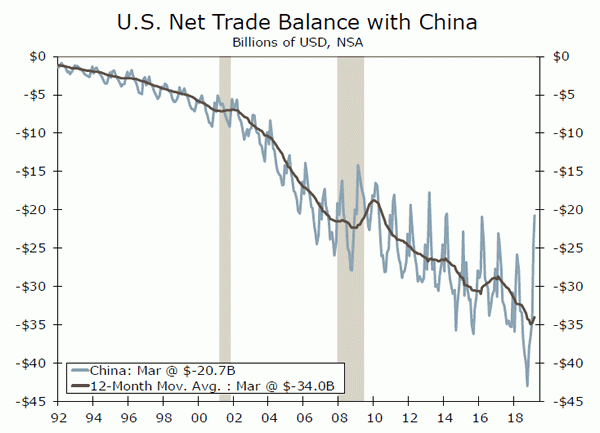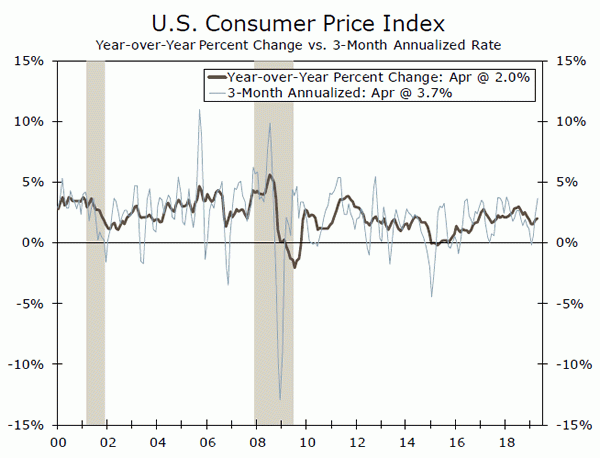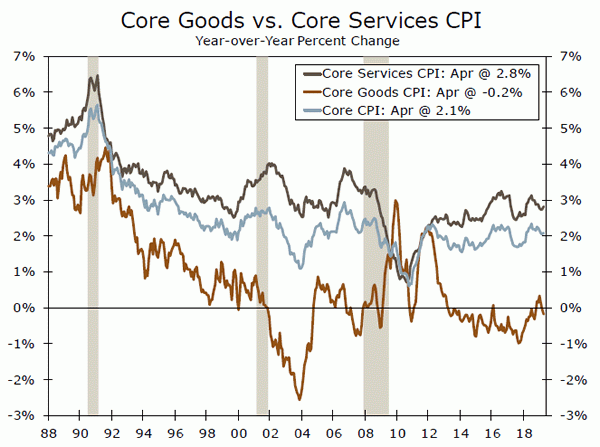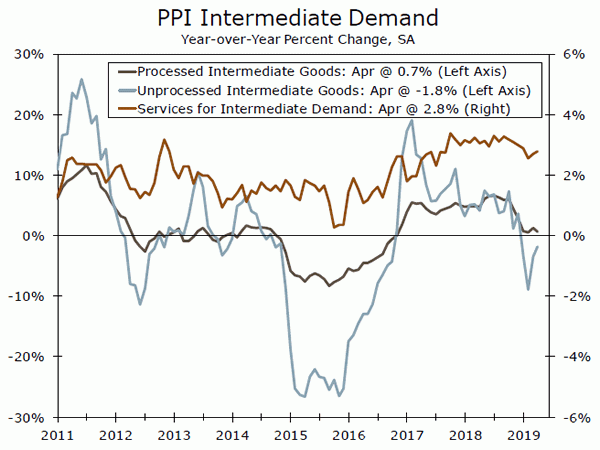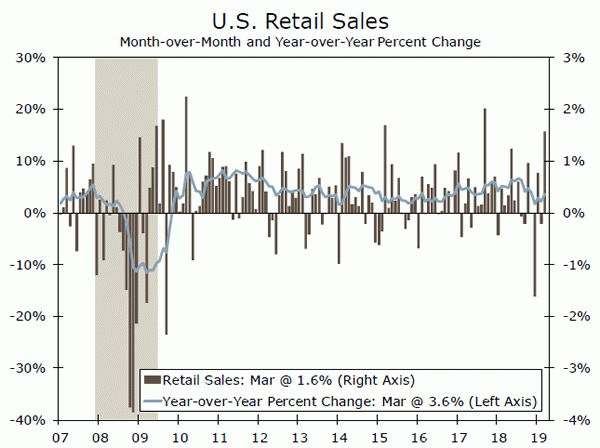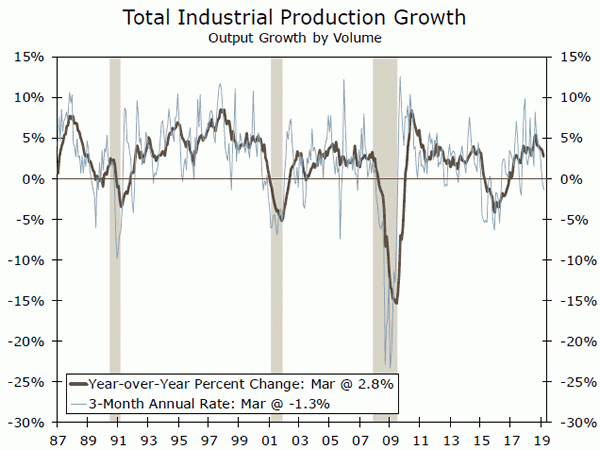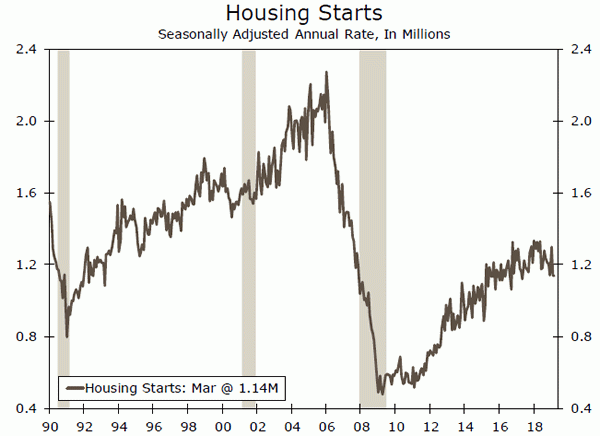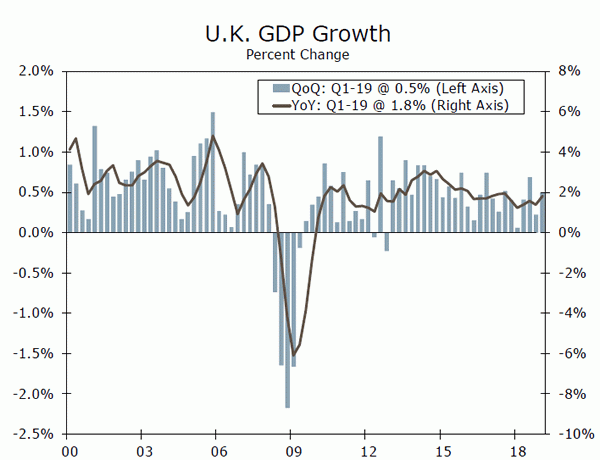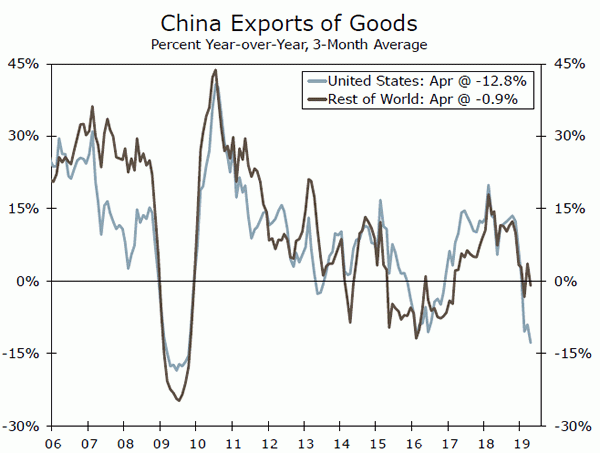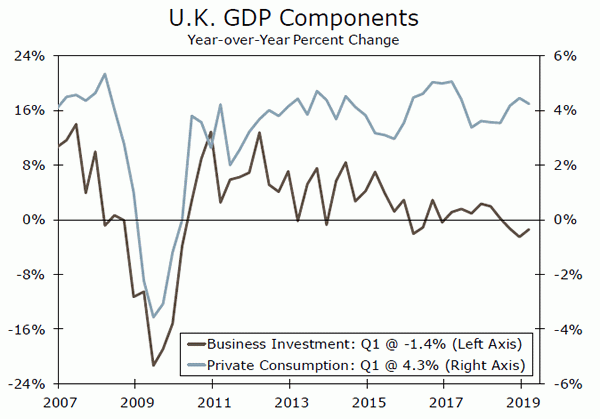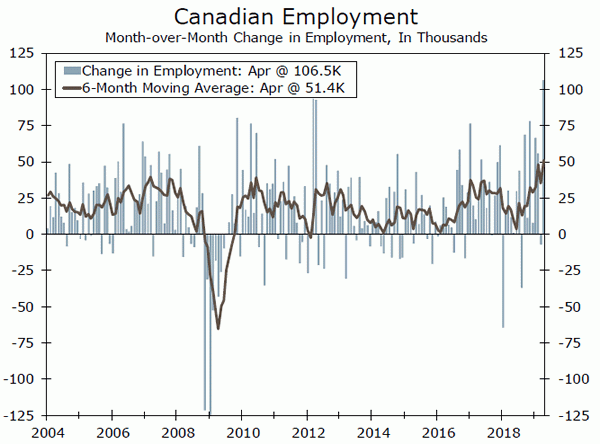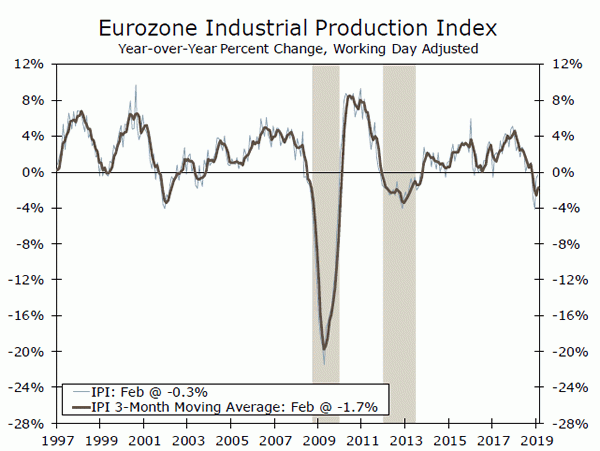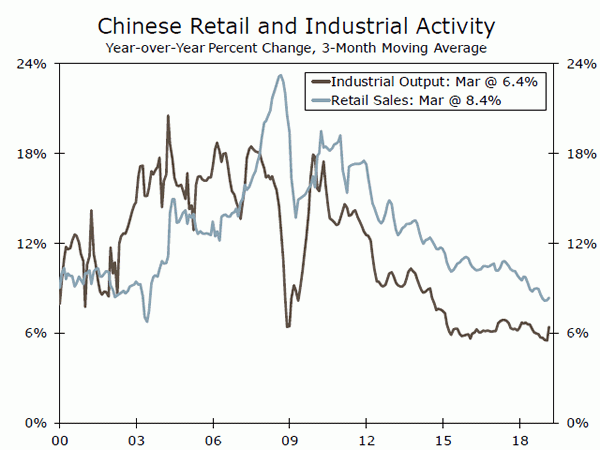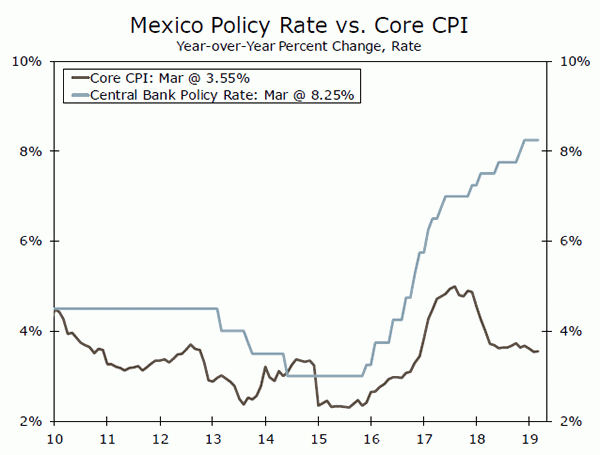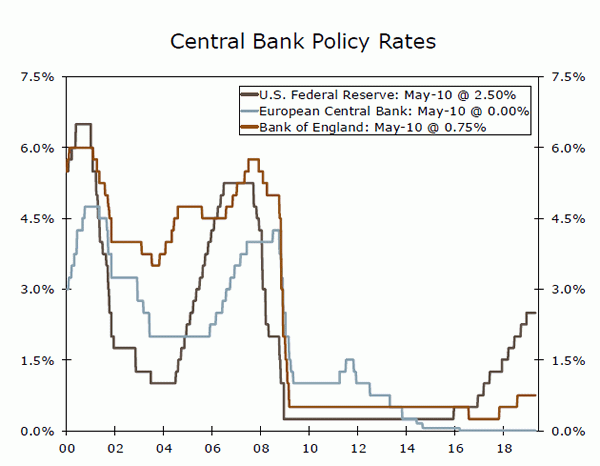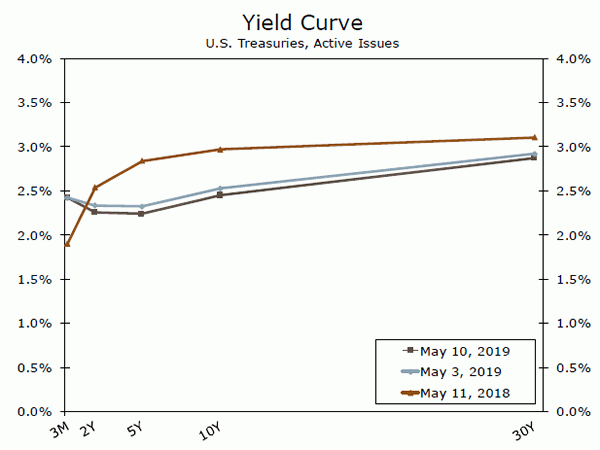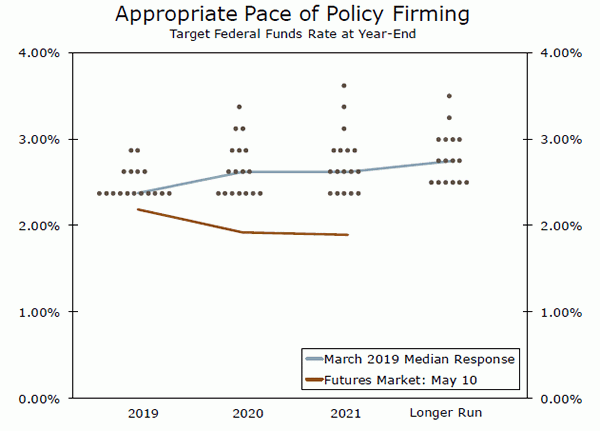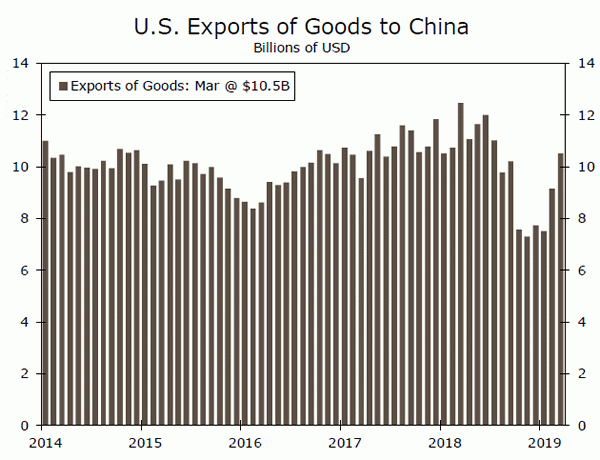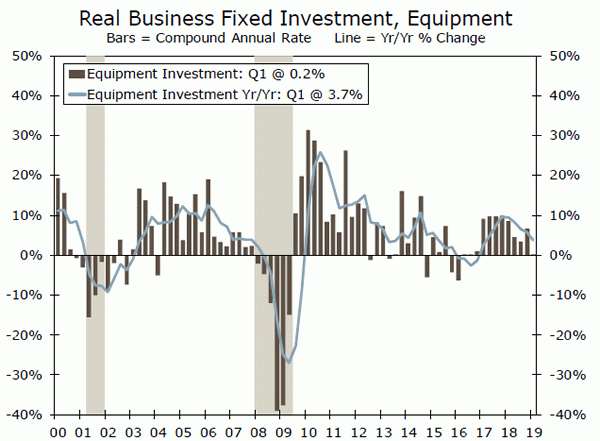U.S. Review
All Trade, All the Time
- Prior to the recent escalation, there had actually been something of a détente in the trade war. China’s informal agreement to buy more U.S. soybeans helped shrink the trade deficit with China to its smallest since 2016. This could reverse if a deal is not reached soon.
- The consumer price index this week indicated that inflation continues to run close to the FOMC’s target. This week’s substantial rise in tariffs, however, is set to put upward pressure on inflation.
All Trade, All the Time
Tariff concerns dominated the headlines this week following President Trump’s threat on Sunday to raise tariffs on $200 billion worth of Chinese imports to 25% from 10% at present. We discuss the potential fallout from the tariff hike and renewed bout of uncertainty stemming from trade policy in our Topic of the Week on page 7. Data this week, however, provided a fresh look at where the trade deficit and inflation are heading into what could be a tumultuous period for imports, exports and pricing.
The trade deficit widened slightly in March to $50.0 billion. Exports posted an increase for the third consecutive month, but imports jumped 1.1% after a measly gain in February and a drop in January. The widening does not look to be quite as large as the BEA estimated heading into the initial release of Q1 GDP, suggesting the boost from trade may get revised lower.
Amid a quasi-pause in the trade war with China as negotiations were progressing, the bilateral deficit with China narrowed in March to the smallest gap in about three years. Soybean exports, which had been caught in the crosshairs of the trade battle, jumped more than half a billion dollars, presumably contributing to the narrower deficit with China. With trade tensions flaring again and the possibility of retaliatory tariffs, exports to China may come under renewed pressure.
At Least Inflation Is Low…For Now
With tariffs back in the spotlight, the upside risks to inflation are back as well. We estimate that this week’s tariff hike could raise consumer price inflation up to 0.15 bps when measured on a year-ago basis. That is likely to be an upper bound, however, as reduced demand, a stronger dollar, existing contracts and some absorption by businesses limit the blow. If tariffs of 25% are extended to all imports from China, including many finished consumer goods, the impact to inflation would be more noticeable. For now, inflation remains relatively quiescent. Consumer prices rose 0.3% during April and 2.0% over the year, a somewhat softer increase than expected. The topline measure was boosted by higher energy prices, which saw a monthly increase of 2.9% alongside rising oil prices. Shelter prices gained 0.4% in April, stemming from higher rents of primary residences. However food, apparel and used vehicle prices each registered a monthly decline. Excluding volatile food and energy prices, prices rose 0.1% during the month but ticked up to a 2.1% gain over the past year.
Producer prices were also fairly tame in April, but suggest inflation is edging up again. Prices for goods and services made by domestic producers increased more slowly than expected in March, but that was largely due to the volatile trade services component, which measures retail and wholesale margins. Our preferred measure of core PPI, which strips out food, energy and trades services, rose 0.4% and has turned up again on a year-over-year basis. At 2.2%, however, and with only moderate growth in input costs, the upturn does not suggest inflation is about to become unhinged.
And while the labor market remains solid, it is not tightening without abandon. Job openings rebounded in March, but remain off the highs reached last year. Initial jobless claims were also little changed from last week, pushing the four-week average back above 2018’s lows.
U.S. Outlook
Retail Sales • Wednesday
March retail sales rose 1.6% over the month with gains in every category except sporting goods. Headline sales were boosted by a 3.1% increase in motor vehicle sales and a gain at gas stations, largely due to higher prices at the pump in March. Excluding volatile components, the control group unexpectedly rose 1.0%, suggesting that the U.S. consumer has not gone into hiding. Online retailers saw monthly gains for the third straight month, after a soft patch in Q4-2018.
Consumer confidence also rose more than expected in April, providing some momentum for the consumer going into the second quarter. Consumers were able to regain some lost confidence after some positive developments in equity markets. Despite the strong data in March, it was not enough to prevent real consumption growth from slowing in the first quarter—PCE grew at an annualized pace of 1.2%. We look for a 0.2% increase in April retail sales.
Previous: 1.6% Wells Fargo: 0.2% Consensus: 0.2% (Month-over-Month)
Industrial Production • Wednesday
The industrial sector continues to lose momentum as total production edged down 0.1% month-over-month in March. The weakness was more pronounced in motor vehicle parts, which fell 2.5% and is down 4.5% over the past year. Mining output also softened 0.8% due to the drop in oil prices in late 2018 and reduced extraction of coal. We expect mining output to make modest positive contributions to growth, however, in the coming months.
The slowdown in production has raised concern about the outlook for manufacturing, as continued trade uncertainty and slower global growth have caused the sector to struggle.
We may see a flat number here in April, and any gains are likely to remain modest. We continue to monitor the ISM manufacturing index, which is lower on trend in recent months, despite not reaching recessionary territory.
Previous: -0.1% Wells Fargo: 0.0% Consensus: 0.0% (Month-over-Month)
Housing Starts • Thursday
Housing starts continued to struggle in March, dropping 0.3% after declining 12% the prior month. Starts have fallen six out of the past seven months with permits showing a similar trend, falling for the past three months. Single-family permits fell 1.1% while multifamily permits fell an even-larger 2.7%. Despite the decline, permits for both single-family and multifamily homes remain well above starts, suggesting we should see an improvement in building activity later this year.
Homebuilding confidence has risen as expectations for single-family home sales over the next six months have improved slightly. Despite a sluggish first quarter, we do not think homebuilding is as slow as the data suggest. The weakened housing market has already slowed price appreciation and encouraged builders to undertake value engineering. The housing market will be watched closely as the spring selling season is upon us.
Previous: 1,139K Wells Fargo: 1,190K Consensus: 1,218K
Global Review
Global Trade Risks Reemerge
- The decision from U.S. President Trump to raise tariffs on Chinese goods this week increases the downside risks to global growth, and the pressure is now even higher on China and the United States to reach a trade deal. The latest tariff increase could shave about 0.2 percentage points off Chinese GDP growth in 2019, depending how Chinese policymakers respond.
- U.K. GDP growth was strong in Q1, and while some of that strength reflected inventory building, underlying domestic demand was more robust than expected. Canada’s employment data printed a bit soft, but the labor market is still generally holding up well despite weakening economic growth.
Not This Again…
Global trade risk is back in focus after U.S. President Trump raised the 10% tariff on US$200 billion worth of Chinese goods to 25%. The reemergence and escalation in the U.S.-China trade tensions pose downside risk to our Chinese GDP growth forecast (currently 6.2% for 2019), as we think it could shave off around 0.2 percentage points off GDP growth this year depending on the policy response from Chinese authorities. China has previously hinted that it could dial back the degree of policy support it has been providing, likely a response to easing tariff risks and leverage concerns. However, now that trade risks have escalated, we would expect a commensurate response from Chinese authorities to contain the economic risks. Already this week, Chinese policymakers announced lower reserve requirement ratios (RRR) for small and mid-sized banks, and we would expect more measures to be forthcoming in the days and weeks ahead. Chinese trade data for April released this week showed the previously implemented tariffs may have already had a notable impact. The trade surplus narrowed to US$13.8 billion, driven by a sharp slowdown in exports and a jump in imports. Digging into the details, Chinese exports to the United States have shown considerably more weakness than exports to the rest of the world. Now that the tariffs have been raised, Chinese exports to the United States could come under even more pressure. The next steps are unclear—China threatened to retaliate earlier this week, but since then has not announced any specific countermeasures.
Shifting gears to Europe, data from the United Kingdom released this week showed strong growth for Q1. GDP rose 0.5% (not annualized) on a sequential basis during the quarter, matching expectations. A closer look at the data shows growth was partly driven by temporary inventory building ahead of Brexit, but underlying domestic demand was also stronger than expected. Private consumption rose 0.7% during the quarter, while business investment unexpectedly rose 0.5%, the first increase in more than a year. The data bode well for the U.K. economy, and run counter to the narrative that activity in Q1 was driven mainly by pre-Brexit stockpiling. We now see greater upside risks to our 2019 U.K. GDP forecast of 1.3%. On the political front, talks to resolve Brexit between the U.K. Conservative and Labour parties have thus far yielded nothing in the way of tangible results, and it seems the Brexit stalemate is poised to linger for the foreseeable future. The contrast between Brexit uncertainty and strong domestic growth is a bit difficult to square, but for now it seems the economy is determined to shrug off any concerns.
Making our way back around to North America, Canada’s jobs numbers for April came in well above expectations, as the monthly job gain of 106,500 was the largest on record. Full-time jobs accounted for the bulk of the gain, while the jobless rate edged lower to 5.7% even as labor force participation ticked higher. Canada’s labor market has been remarkably resilient despite weakness in economic growth, and we think labor market developments will be key to watch if growth continues to falter.
Global Outlook
Eurozone Industrial Output • Tuesday
The Eurozone economy is starting to show tentative signs of stabilization, as Q1 GDP rose a more solid 0.4% (not annualized) on a sequential basis. A nearly 2% month-over-month jump in industrial output in January may have helped the overall growth print, but output fell modestly in February and the consensus expectation is for a 0.3% drop in March. These figures suggest the economy lost some momentum by the end of the quarter.
To be sure, retail sales were also strong in Q1, a positive sign for consumer spending activity. We will not get a full breakdown of GDP into its demand-side components for another month, so these monthly activity figures are one of the few ways to ascertain the drivers of demand growth for now. Business fixed investment and consumer spending were underwhelming in the second half of 2018, and it will be important to gauge the performance of these two components of domestic demand in Q1.
Previous: -0.2% Consensus: -0.3% (Month-over-Month)
China Economic Activity • Tuesday
China is another economy that has shown some signs of more stable growth recently, as Q1 GDP growth beat expectations with a 6.4% year-over-year gain. Monthly activity figures, including industrial output and retail sales, were solid for March, suggesting the economy carried some momentum into Q2. In that sense, next week’s release of key activity figures for April, including industrial output and retail sales, will be important in gauging whether the Chinese economy kept that solid momentum going at the start of Q2.
These figures will not, however, capture any of the possible disruptions that could come from President Trump’s latest decision to raise tariffs on Chinese goods. We will have to wait until the release of the May PMIs at the end of the month before we can get a sense for how these actions affected sentiment. Until then, the financial market response will be more instructive.
Previous: Industrial Output 6.4%, Retail Sales 8.4% Consensus: Industrial Output 6.5%, Retail Sales 8.4%
Banxico Policy Announcement • Thursday
At a time when most central banks around the globe have turned more dovish, Mexico’s central bank has been hesitant to change its hawkish tune. That is particularly interesting given just how tight monetary policy is in Mexico right now—the policy rate currently stands at 8.25%, while core inflation is running at just 3.5%, implying a real policy rate of nearly 5%. The tightness of Mexican monetary policy highlights the concern among policymakers over upside inflation risks, but high real interest rates are increasingly showing signs of weighing on interest-rate sensitive sectors of the Mexican economy, such as investment spending.
Eventually, we expect the central bank to capitulate and start to signal rate cuts. The currency has been reasonably stable and concerns about Mexico’s political situation have lessened for now, and the central bank may take advantage of this relative stability in the domestic situation to ease policy.
Previous: 8.25% Consensus: 8.25%
Point of View
Interest Rate Watch
Higher Tariffs—Lower Rates?
President Trump’s tweet last week announcing his intention to boost tariffs on Chinese goods to 25% from 10% and possibly extend tariffs to virtually all Chinese imports rattled the financial markets this week. The prior thinking was that the trade negotiations were making progress and that a formal agreement would be signed in mid-June. That still may happen, but the latest rift, which appears to have been brought on by the inability to agree on an enforcement mechanism, has reintroduced considerable uncertainty as to when and if an agreement will be reached.
The lack of a trade deal and rise in tariffs will slow global economic growth even further, which means U.S. manufacturing activity and inflation are both likely to decelerate further as well. Long-term yields fell slightly over the week but the Treasury auctions went poorly, which has kept the slope of the yield curve solidly positive. With tariffs and the expanded trade war apparently worsening, the odds of a cut in the federal funds rate have increased. Federal funds futures currently imply two quarter-point rate cuts by the end of 2020. We currently have one rate cut, at the end of 2020, which might need to be pulled forward if the increased uncertainty causes real economic growth to slow, which seems likely.
The remarkably tame inflation data give the Federal Reserve plenty of room to maneuver. Both the PPI and CPI data came in slightly below expectations during April. The headline CPI rose 0.3%, largely behind a big increase in gasoline prices. Prices excluding food and energy rose just 0.1%, however, which was below expectations. The core CPI has risen 2.1% over the past year but the core PCE deflator, which is the Fed’s preferred price gauge, is up just 1.6%.
While some Fed participants have raised concerns about lower inflation, the economy continues to show a great deal of resilience. Solid job growth and an unemployment rate of just 3.6% likely create a fairly high bar for the Federal Reserve to cut rates. That said, growing concerns about trade likely raise the bar even further on any potential rate hikes.
Credit Market Insights
C&I Credit Crunch?
U.S. bank respondents reported to the Federal Reserve that demand decreased among all major loan categories in the first quarter. Banks were more willing to extend credit, however, likely reflecting the notably more dovish stance among global central banks. Credit standards are reported in the Senior Loan Officer Opinion Survey (SLOOS), which is released by the Federal Reserve and asks participating banks to gauge lending practices and behaviors.
Demand for Commercial & Industrial (C&I) loans was reported to be notably weaker in the first quarter. The net percentage of firms reporting strong demand for C&I loans from Large & Medium firms was -16.9%—the weakest since the Great Recession. Actual records of banks’ balance sheets, tracked by the Fed’s H.8 report, however, show credit is being extended. Indeed, C&I loans grew an annualized pace of 9.8% in Q1-2019.
The decreased demand hasn’t yet translated into lower lending volumes, but could this be the start of a C&I credit crunch? With demand for C&I loans steadily declining since 2014, we do not expect a renewed pick-up in demand. But, banks eased standards for such loans in the first quarter, likely providing some incentive to firms for impending investment. We would need to see a large retrenchment in banks’ willingness to extend credit, coupled with tightening of standards, before we became truly worried of a forthcoming suppression in C&I lending.
Topic of the Week
Doubling Down on Tariffs
The increase to 25% from 10% previously on $200 billion of various Chinese goods imports went into effect earlier today, and while some products in transit may be allowed in on a temporary basis, the hope that “cooler heads will prevail” was dashed once again.
Still, a new deal with China could emerge soon and the administration had positive remarks about a letter received from Chinese President Xi Jinping. For now, however, the Chinese trade delegation leaves Washington without a deal in hand and amid heightened financial market anxiety. The VIX index, a measure of volatility, is nearing levels last seen in December’s market swoon.
For now, the $325 billion in new tariffs on other Chinese imported goods has not yet gone into effect. Though the President said those tariffs would go into effect “shortly” and would also be at the higher 25% rate, U.S. law requires public hearings and a comment period.
Prior to the recent escalation from the President’s tweets over the weekend, there had actually been something of a détente in the trade war, with China agreeing to buy more U.S. soybeans, for example. Soybean exports jumped by more than half a billion dollars in March, meaning exports of that crop alone accounted for about a quarter of the $2.1 billion increase in overall goods exports. This has occurred alongside a rebound in U.S. exports to China (top chart). This could reverse if a deal is not reached soon.
Beyond just buying fewer U.S. soybeans, the Chinese government could increase the existing tariff rate on a variety of U.S. imported goods already subject to Chinese tariffs, which would likely put renewed pressure on U.S exports.
The increased trade tension with China could lead some businesses to infer that the administration is potentially embarking on a more aggressive trade policy stance. The deceleration in business investment in equipment in recent quarters could reflect, at least in part, uncertainty related to trade policy (bottom chart).




